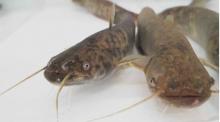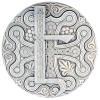SHINGU, Wakayama -- A team of researchers in Japan has succeeded in making catfish all female with a compound found in soybeans -- a development that promises to increase the production efficiency of this and other species whose females are more valuable than males in the food market.
The team, from Kindai University's Aquaculture Research Institute and based at the institute's Shingu Station in Shingu, Wakayama Prefecture, used isoflavone -- a compound found in soybeans similar in effect to female hormones -- to create the all-female groups of catfish. The feat is a Japan first, according to the university.
As female catfish grow faster than males, "by making them all female, production efficiency will rise," commented team leader and aquaculture science associate professor Toshinao Ineno. "This can be applied to other farm-raised fish whose females are more valuable."
According to Ineno, in catfish cultivation, which has been attracting attention as an alternative to increasingly scant eel, females grow to shipping weight -- at least 600 grams -- in six to 10 months after hatching. Males, which grow more slowly, are often discarded. Though it has been known that administering female hormone turns male catfish into females, this method is banned for fish for human consumption. So Ineno came up with the idea of using soybean isoflavone, which is sold commercially as a dietary supplement.
The experiment was conducted with catfish divided into five different tanks; one of regular fish farming water; three with different concentrations of "genistein," a chemical component of soybean isoflavone; and one with female hormone dissolved in the water. The team kept 150 fry in each tank for 15 days, before transferring them to ordinary water until they were 150 days old. While 68% of catfish in the ordinary water tank were female, 96% of the catfish kept in the water with genistein at a concentration of 100 micrograms per liter were female. A concentration of 400 micrograms per liter yielded a 100% female group, the same as in the female hormone-treated water group.
Though the extracted genistein was used as the reagent in the experiment, the method is prohibited in the farming of fish for human consumption. Ineno said, "In future, we'd like to think of methods in which catfish can take in soybean isoflavone in their food, such as soy lees." He also added that the team intends to try making sturgeons -- the fish that produce caviar -- female using soybean isoflavone as well.
(Japanese original by Yukihiro Takeuchi, Tanabe Local Bureau)

